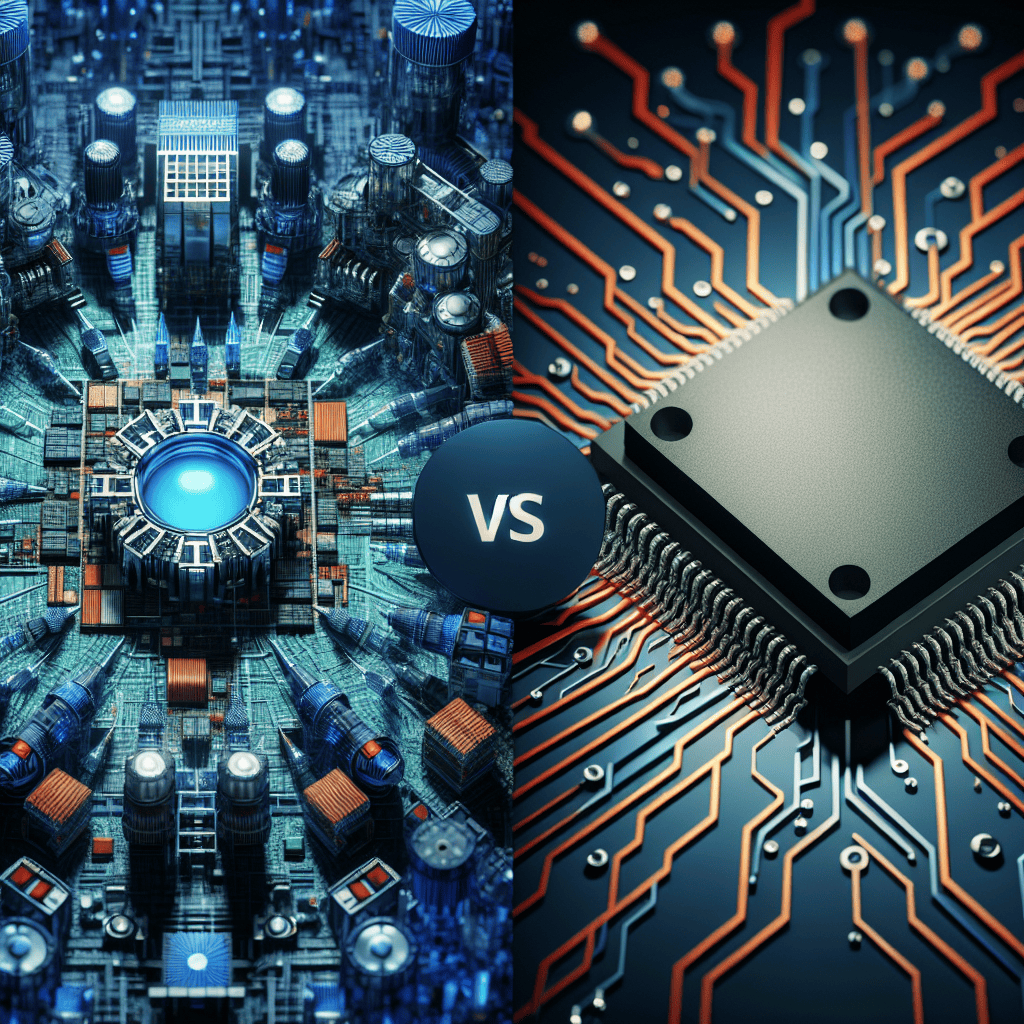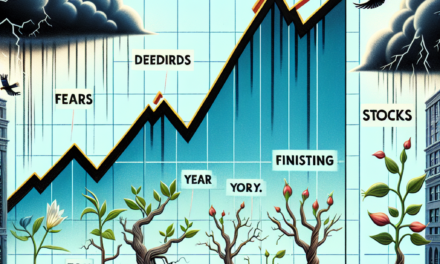“Top Chip Stock Showdown: ASML vs. TSMC – Powering the Future of Technology.”
Introduction
In the rapidly evolving semiconductor industry, two giants stand out as pivotal players: ASML Holding N.V. and Taiwan Semiconductor Manufacturing Company (TSMC). Both companies are integral to the global chip supply chain, yet they occupy distinct niches within the sector. ASML, a Dutch company, is renowned for its cutting-edge lithography machines, which are essential for producing the most advanced semiconductor chips. On the other hand, TSMC, based in Taiwan, is the world’s largest dedicated independent semiconductor foundry, responsible for manufacturing chips for tech giants like Apple, NVIDIA, and AMD. As the demand for semiconductors continues to surge, driven by advancements in artificial intelligence, 5G, and the Internet of Things, investors and industry analysts are keenly observing these two powerhouses. The showdown between ASML and TSMC is not just a battle of market dominance but also a reflection of the broader technological and geopolitical trends shaping the future of the semiconductor industry.
Market Position: ASML vs. TSMC
In the rapidly evolving semiconductor industry, two giants stand out for their pivotal roles in shaping the market: ASML Holding N.V. and Taiwan Semiconductor Manufacturing Company (TSMC). Both companies have carved out significant positions within the semiconductor supply chain, yet they occupy distinct niches that highlight their unique contributions and competitive advantages. Understanding their market positions requires a closer examination of their business models, technological prowess, and strategic initiatives.
ASML, a Dutch company, is renowned for its cutting-edge lithography machines, which are essential for producing the intricate patterns on silicon wafers that form the basis of semiconductor chips. As the sole supplier of extreme ultraviolet (EUV) lithography equipment, ASML holds a near-monopoly in this critical segment of the market. This exclusivity grants ASML a formidable competitive edge, as EUV technology is indispensable for manufacturing the most advanced chips used in high-performance computing, artificial intelligence, and 5G applications. Consequently, ASML’s market position is bolstered by its technological leadership and the high barriers to entry for potential competitors.
In contrast, TSMC, headquartered in Taiwan, is the world’s largest dedicated independent semiconductor foundry. TSMC’s business model revolves around manufacturing chips for a diverse array of clients, including tech giants like Apple, NVIDIA, and Qualcomm. This client-centric approach allows TSMC to leverage economies of scale and maintain a dominant market share in the foundry sector. TSMC’s ability to produce chips at various process nodes, from mature technologies to cutting-edge 3nm processes, underscores its versatility and adaptability in meeting the evolving demands of the semiconductor industry.
While ASML and TSMC operate in different segments of the semiconductor supply chain, their market positions are interlinked. ASML’s EUV machines are crucial for TSMC’s production of advanced chips, creating a symbiotic relationship between the two companies. This interdependence highlights the intricate dynamics of the semiconductor ecosystem, where collaboration and competition coexist. Moreover, both companies are investing heavily in research and development to maintain their technological edge and address the growing demand for semiconductors across various industries.
Transitioning to the financial aspects, ASML’s market position is reflected in its robust financial performance, characterized by strong revenue growth and healthy profit margins. The company’s ability to command premium pricing for its EUV machines contributes to its financial stability and enables continued investment in innovation. Similarly, TSMC’s financial strength is evident in its consistent revenue growth and substantial capital expenditures aimed at expanding production capacity and advancing process technologies. TSMC’s strategic investments in new fabs and advanced packaging technologies further solidify its market position and ensure its competitiveness in the global semiconductor landscape.
In conclusion, ASML and TSMC occupy distinct yet complementary positions within the semiconductor market. ASML’s dominance in lithography technology and TSMC’s leadership in chip manufacturing exemplify their respective strengths and strategic importance. As the demand for semiconductors continues to surge, driven by trends such as digital transformation and the Internet of Things, both companies are well-positioned to capitalize on these opportunities. Their ongoing investments in innovation and capacity expansion will likely reinforce their market positions, ensuring their continued influence in shaping the future of the semiconductor industry.
Technological Innovations: Comparing ASML and TSMC
In the rapidly evolving landscape of semiconductor technology, two giants stand out for their pivotal roles in shaping the future of chip manufacturing: ASML Holding N.V. and Taiwan Semiconductor Manufacturing Company (TSMC). Both companies are integral to the semiconductor supply chain, yet they occupy distinct niches that complement each other. Understanding their technological innovations and strategic positions provides insight into the broader dynamics of the semiconductor industry.
ASML, a Dutch company, is renowned for its cutting-edge lithography machines, which are essential for producing the intricate patterns on silicon wafers that form the basis of modern microchips. The company’s most advanced technology, Extreme Ultraviolet (EUV) lithography, has revolutionized the industry by enabling the production of smaller, more powerful, and energy-efficient chips. EUV lithography is a critical enabler for the continuation of Moore’s Law, which predicts the doubling of transistors on a microchip approximately every two years. ASML’s dominance in this niche is underscored by its near-monopoly on EUV technology, making it an indispensable partner for chip manufacturers aiming to stay at the forefront of innovation.
On the other hand, TSMC, based in Taiwan, is the world’s largest dedicated independent semiconductor foundry. It specializes in the fabrication of chips designed by other companies, such as Apple, NVIDIA, and Qualcomm. TSMC’s strength lies in its ability to produce high volumes of advanced chips with exceptional precision and reliability. The company’s commitment to research and development has allowed it to consistently lead in process technology, with its 5-nanometer and 3-nanometer nodes setting industry benchmarks. TSMC’s strategic investments in expanding its manufacturing capacity and its focus on sustainability further solidify its position as a leader in the semiconductor manufacturing sector.
While ASML and TSMC operate in different segments of the semiconductor industry, their collaboration is crucial. ASML’s EUV machines are integral to TSMC’s ability to produce cutting-edge chips. This symbiotic relationship highlights the interconnectedness of the semiconductor ecosystem, where advancements in one area can drive progress in another. Moreover, both companies are investing heavily in research and development to address the growing demand for semiconductors driven by emerging technologies such as artificial intelligence, 5G, and the Internet of Things.
Despite their successes, ASML and TSMC face challenges that could impact their future trajectories. For ASML, the complexity and cost of developing next-generation lithography machines pose significant hurdles. The company must continue to innovate while managing the financial and technical risks associated with pushing the boundaries of what is technologically possible. Meanwhile, TSMC must navigate geopolitical tensions, particularly those involving Taiwan, which could affect its operations and supply chain. Additionally, the company faces increasing competition from other foundries seeking to capture a share of the lucrative semiconductor market.
In conclusion, ASML and TSMC are at the forefront of technological innovations in the semiconductor industry, each playing a unique and complementary role. ASML’s advancements in lithography technology and TSMC’s prowess in chip manufacturing are driving forces behind the continued miniaturization and enhancement of microchips. As they navigate the challenges and opportunities ahead, their contributions will undoubtedly shape the future of technology, influencing everything from consumer electronics to advanced computing systems. The interplay between these two industry leaders exemplifies the collaborative spirit necessary to propel the semiconductor industry into the next era of innovation.
Financial Performance: ASML and TSMC Analysis
In the realm of semiconductor manufacturing, ASML Holding N.V. and Taiwan Semiconductor Manufacturing Company (TSMC) stand as titans, each playing a pivotal role in the global supply chain. Analyzing their financial performance offers insights into their market positions and future prospects. ASML, a Dutch company, is renowned for its lithography machines, which are essential for producing advanced semiconductor chips. On the other hand, TSMC, based in Taiwan, is the world’s largest dedicated independent semiconductor foundry, serving a diverse range of clients with its cutting-edge manufacturing capabilities.
To begin with, ASML’s financial performance has been marked by consistent growth, driven by its near-monopoly in the extreme ultraviolet (EUV) lithography market. This technology is crucial for producing the most advanced chips, and ASML’s dominance in this area has translated into robust revenue streams. In recent years, ASML has reported impressive revenue growth, with a significant portion attributed to the increasing demand for EUV machines. This demand is fueled by the global push towards more powerful and efficient chips, which are essential for applications ranging from smartphones to artificial intelligence.
In contrast, TSMC’s financial performance is characterized by its expansive production capabilities and a broad client base that includes tech giants such as Apple and NVIDIA. TSMC’s ability to produce chips at various nodes, including the most advanced 5nm and 3nm processes, has positioned it as a leader in the semiconductor industry. The company’s revenue growth has been bolstered by the rising demand for high-performance computing and 5G technologies. Furthermore, TSMC’s strategic investments in expanding its production capacity have enabled it to meet the surging demand, thereby maintaining its competitive edge.
While both companies have demonstrated strong financial performance, their business models and market strategies differ significantly. ASML’s focus on supplying critical equipment to chip manufacturers means its revenue is closely tied to the capital expenditure cycles of its clients. This can lead to fluctuations in financial performance based on the investment decisions of semiconductor manufacturers. However, ASML’s technological leadership in EUV lithography provides a competitive moat, ensuring sustained demand for its products.
Conversely, TSMC’s foundry model allows it to benefit directly from the growing demand for semiconductors across various industries. Its ability to attract and retain major clients is a testament to its technological prowess and operational efficiency. TSMC’s financial performance is less susceptible to the cyclical nature of capital expenditures, as it benefits from long-term contracts and a diversified client base. This stability is further enhanced by TSMC’s ongoing efforts to innovate and push the boundaries of semiconductor manufacturing.
In conclusion, both ASML and TSMC exhibit strong financial performance, albeit through different avenues. ASML’s dominance in EUV lithography positions it as a critical player in the semiconductor supply chain, while TSMC’s expansive production capabilities and client relationships underpin its leadership in the foundry market. As the demand for advanced semiconductors continues to rise, both companies are well-positioned to capitalize on these trends. However, their distinct business models and market strategies will likely influence their financial trajectories in the coming years, making the competition between these two industry giants a compelling narrative to follow.
Supply Chain Strategies: ASML vs. TSMC

In the rapidly evolving semiconductor industry, supply chain strategies are pivotal in determining the success and resilience of companies. Two giants in this field, ASML Holding N.V. and Taiwan Semiconductor Manufacturing Company (TSMC), have developed distinct approaches to managing their supply chains, each tailored to their unique roles within the industry. Understanding these strategies provides insight into how these companies maintain their competitive edge and adapt to global challenges.
ASML, a Dutch company, is the world’s leading supplier of photolithography equipment, which is essential for semiconductor manufacturing. Its supply chain strategy is heavily focused on innovation and collaboration. ASML’s products are highly specialized and technologically advanced, requiring a robust network of suppliers who can meet stringent quality and precision standards. To ensure a steady supply of critical components, ASML invests in long-term partnerships with its suppliers, often providing them with technical support and guidance. This collaborative approach not only secures the supply of high-quality components but also fosters innovation, as suppliers are encouraged to develop new technologies that can be integrated into ASML’s systems.
Moreover, ASML’s supply chain strategy emphasizes flexibility and resilience. The company has implemented measures to mitigate risks associated with geopolitical tensions and supply chain disruptions. For instance, ASML has diversified its supplier base across different regions, reducing dependency on any single source. This diversification is complemented by strategic stockpiling of essential components, ensuring that production can continue even in the face of unexpected disruptions. By maintaining a balance between innovation, collaboration, and risk management, ASML has positioned itself as a leader in the semiconductor equipment market.
In contrast, TSMC, the world’s largest contract chip manufacturer, has developed a supply chain strategy that focuses on efficiency and scale. TSMC’s business model relies on producing a vast array of semiconductor products for a diverse clientele, ranging from consumer electronics to automotive industries. To meet the demands of its clients, TSMC has established a highly efficient supply chain that prioritizes speed and cost-effectiveness. The company leverages its massive production capacity and economies of scale to negotiate favorable terms with suppliers, ensuring a steady flow of raw materials and components.
TSMC’s supply chain strategy also incorporates advanced logistics and inventory management systems. By utilizing real-time data analytics, TSMC can optimize its production schedules and inventory levels, minimizing waste and reducing lead times. This data-driven approach allows TSMC to respond swiftly to changes in market demand, maintaining its reputation for reliability and timely delivery. Furthermore, TSMC invests heavily in research and development, collaborating with suppliers to enhance the quality and performance of materials used in its manufacturing processes.
While both ASML and TSMC have developed effective supply chain strategies, their approaches reflect their distinct roles within the semiconductor industry. ASML’s focus on innovation and collaboration aligns with its position as a technology leader, while TSMC’s emphasis on efficiency and scale supports its role as a high-volume manufacturer. Despite these differences, both companies recognize the importance of resilience and adaptability in navigating the complexities of the global supply chain landscape. As the semiconductor industry continues to face challenges such as geopolitical tensions and supply chain disruptions, the strategies employed by ASML and TSMC will be crucial in maintaining their competitive advantage and driving future growth.
Future Growth Prospects: ASML and TSMC
In the rapidly evolving semiconductor industry, two giants stand out for their pivotal roles in shaping the future of technology: ASML Holding N.V. and Taiwan Semiconductor Manufacturing Company (TSMC). Both companies are integral to the semiconductor supply chain, yet they occupy distinct niches that complement each other. As the demand for advanced chips continues to surge, understanding the future growth prospects of ASML and TSMC becomes crucial for investors and industry stakeholders alike.
ASML, a Dutch company, is the world’s leading supplier of photolithography equipment, which is essential for producing the intricate patterns on semiconductor wafers. Its cutting-edge extreme ultraviolet (EUV) lithography machines are indispensable for manufacturing the most advanced chips. As the semiconductor industry pushes towards smaller and more efficient nodes, ASML’s technology becomes increasingly critical. The company’s near-monopoly in EUV technology positions it favorably for future growth, as chipmakers worldwide rely on its machines to stay competitive. Furthermore, ASML’s continuous investment in research and development ensures that it remains at the forefront of innovation, ready to meet the evolving demands of the industry.
On the other hand, TSMC, based in Taiwan, is the world’s largest contract chip manufacturer. It plays a crucial role in the semiconductor ecosystem by fabricating chips for a diverse range of clients, including tech giants like Apple, NVIDIA, and Qualcomm. TSMC’s ability to produce high-performance chips at scale has made it an indispensable partner for companies seeking to leverage cutting-edge technology. As the world becomes increasingly digital, the demand for TSMC’s services is expected to grow exponentially. The company’s strategic investments in expanding its manufacturing capacity, particularly in advanced nodes like 5nm and 3nm, underscore its commitment to maintaining its leadership position in the industry.
While both ASML and TSMC are poised for growth, their paths are intertwined yet distinct. ASML’s success is closely linked to the adoption of its EUV technology by companies like TSMC. As TSMC continues to push the boundaries of chip manufacturing, it relies heavily on ASML’s equipment to achieve the precision required for next-generation semiconductors. This symbiotic relationship highlights the interdependence of the two companies, with ASML providing the tools and TSMC executing the production.
Looking ahead, several factors will influence the growth trajectories of ASML and TSMC. The global push towards digital transformation, the proliferation of artificial intelligence, and the expansion of the Internet of Things are expected to drive demand for advanced semiconductors. Both companies are well-positioned to capitalize on these trends, with ASML supplying the necessary technology and TSMC delivering the manufacturing prowess. Additionally, geopolitical dynamics, such as trade tensions and supply chain disruptions, could impact their operations. However, both companies have demonstrated resilience and adaptability in navigating such challenges.
In conclusion, ASML and TSMC are at the forefront of the semiconductor industry’s future growth. Their complementary roles and strategic investments position them as key players in meeting the world’s increasing demand for advanced chips. As technology continues to evolve, the collaboration between ASML and TSMC will likely remain a cornerstone of the semiconductor landscape, driving innovation and shaping the future of technology.
Competitive Advantages: ASML vs. TSMC
In the rapidly evolving semiconductor industry, two giants stand out for their pivotal roles in shaping the future of technology: ASML Holding N.V. and Taiwan Semiconductor Manufacturing Company (TSMC). Both companies are integral to the production of advanced microchips, yet they occupy distinct positions within the supply chain, each with its own set of competitive advantages. Understanding these advantages is crucial for investors and industry observers alike, as it sheds light on the strategic strengths that enable these companies to maintain their leadership positions.
ASML, a Dutch company, is the world’s leading supplier of photolithography equipment, which is essential for the production of semiconductor chips. Its most significant competitive advantage lies in its near-monopoly on extreme ultraviolet (EUV) lithography technology. EUV lithography is critical for producing the most advanced chips, as it allows for the creation of smaller, more efficient, and more powerful transistors. ASML’s mastery of this technology has positioned it as an indispensable partner for chip manufacturers aiming to push the boundaries of Moore’s Law. Furthermore, ASML’s substantial investment in research and development ensures that it remains at the forefront of innovation, continually enhancing its equipment’s capabilities and efficiency.
On the other hand, TSMC, based in Taiwan, is the world’s largest dedicated independent semiconductor foundry. Its competitive advantage is rooted in its unparalleled manufacturing capabilities and its ability to produce a wide range of chips for various applications. TSMC’s extensive experience and expertise in chip fabrication allow it to offer cutting-edge process technologies, such as its 5-nanometer and 3-nanometer nodes, which are highly sought after by leading technology companies. Moreover, TSMC’s robust customer relationships, including partnerships with industry giants like Apple, AMD, and NVIDIA, provide it with a steady stream of demand and a diversified revenue base.
While ASML and TSMC operate in different segments of the semiconductor industry, their competitive advantages are interlinked. ASML’s EUV technology is a critical enabler for TSMC’s advanced manufacturing processes. This symbiotic relationship underscores the importance of collaboration in the semiconductor ecosystem, where advancements in equipment technology directly impact the capabilities of chip manufacturers. Consequently, ASML’s success in refining EUV technology not only strengthens its market position but also enhances TSMC’s ability to deliver state-of-the-art chips to its clients.
In addition to their technological prowess, both companies benefit from strategic geographic positioning. ASML, headquartered in Europe, leverages its location to access a diverse talent pool and maintain strong ties with European research institutions. TSMC, situated in Asia, capitalizes on its proximity to major electronics markets and its ability to quickly respond to shifts in consumer demand. These geographic advantages further bolster their competitive positions, enabling them to navigate the complexities of the global semiconductor landscape effectively.
In conclusion, ASML and TSMC each possess unique competitive advantages that solidify their leadership in the semiconductor industry. ASML’s dominance in EUV lithography and its commitment to innovation provide it with a formidable edge in equipment supply. Meanwhile, TSMC’s manufacturing expertise and strong customer relationships ensure its continued success as a leading chip producer. As the demand for advanced semiconductors continues to grow, the interplay between these two companies’ strengths will remain a key driver of technological progress and industry evolution.
Investment Risks: ASML and TSMC
When considering investments in the semiconductor industry, ASML Holding N.V. and Taiwan Semiconductor Manufacturing Company (TSMC) often emerge as prominent contenders. Both companies play pivotal roles in the global chip supply chain, yet they present distinct investment risks that potential investors must carefully evaluate. Understanding these risks is crucial for making informed decisions in a sector characterized by rapid technological advancements and intense competition.
ASML, a Dutch company, is renowned for its lithography machines, which are essential for producing advanced semiconductor chips. The company’s dominance in extreme ultraviolet (EUV) lithography technology positions it as a critical supplier to leading chip manufacturers. However, this reliance on a single product line introduces a significant risk. Any disruption in ASML’s ability to innovate or deliver its cutting-edge machines could have substantial repercussions. Moreover, the high cost and complexity of EUV technology mean that ASML must continuously invest in research and development to maintain its competitive edge. This ongoing need for innovation presents a financial risk, as the company must balance investment with profitability.
In addition to technological risks, ASML faces geopolitical challenges. The semiconductor industry is deeply intertwined with global trade dynamics, and ASML’s operations are not immune to these influences. For instance, export restrictions imposed by governments can impact ASML’s ability to sell its products to certain markets, notably China. Such restrictions could limit ASML’s growth potential and affect its revenue streams. Furthermore, the company’s reliance on a limited number of key customers, such as TSMC and Samsung, means that any changes in these relationships could significantly impact ASML’s financial performance.
On the other hand, TSMC, as the world’s largest contract chip manufacturer, faces its own set of investment risks. The company’s leadership in advanced process technologies, such as 5-nanometer and 3-nanometer nodes, underscores its importance in the semiconductor ecosystem. However, this leadership is not without challenges. The capital-intensive nature of semiconductor manufacturing requires TSMC to make substantial investments in new facilities and equipment. This capital expenditure can strain financial resources, especially if market demand fluctuates or if technological advancements do not yield expected returns.
Moreover, TSMC’s geographic concentration in Taiwan presents geopolitical risks. The ongoing tensions between China and Taiwan pose potential threats to TSMC’s operations. Any escalation in these tensions could disrupt supply chains and impact the company’s ability to meet global demand. Additionally, TSMC’s dependence on a few major customers, such as Apple and AMD, means that shifts in these companies’ strategies or market positions could affect TSMC’s revenue stability.
Both ASML and TSMC also face broader industry risks, such as the cyclical nature of the semiconductor market. Economic downturns can lead to reduced demand for electronic devices, subsequently affecting chip sales. Furthermore, the rapid pace of technological change means that both companies must continuously innovate to stay ahead of competitors. Failure to do so could result in loss of market share and diminished investor confidence.
In conclusion, while ASML and TSMC are leaders in the semiconductor industry, they each present unique investment risks. ASML’s reliance on EUV technology and geopolitical factors, coupled with TSMC’s capital-intensive operations and geopolitical vulnerabilities, highlight the complexities of investing in this sector. Investors must weigh these risks against potential rewards, considering both companies’ strategic positions and the broader industry landscape.
Q&A
1. **What is ASML’s primary business focus?**
ASML specializes in the development and manufacturing of photolithography machines used in the semiconductor industry, particularly known for its EUV (Extreme Ultraviolet) lithography technology.
2. **What is TSMC’s primary business focus?**
TSMC (Taiwan Semiconductor Manufacturing Company) is a leading semiconductor foundry, focusing on manufacturing chips for various clients, including major tech companies, using advanced process technologies.
3. **How does ASML’s technology impact the semiconductor industry?**
ASML’s EUV lithography machines are crucial for producing smaller, more powerful, and efficient chips, enabling the advancement of cutting-edge technologies like AI, 5G, and high-performance computing.
4. **What is TSMC’s competitive advantage in the semiconductor market?**
TSMC’s competitive advantage lies in its advanced manufacturing capabilities, extensive client base, and ability to produce high-performance chips at scale, maintaining a leadership position in the foundry market.
5. **How do ASML and TSMC collaborate in the semiconductor supply chain?**
ASML provides TSMC with advanced lithography equipment, which is essential for TSMC to produce cutting-edge chips, making their collaboration vital for technological advancements in the semiconductor industry.
6. **What are the financial strengths of ASML?**
ASML benefits from high demand for its EUV machines, strong profit margins, and a dominant position in the lithography market, contributing to robust financial performance and growth prospects.
7. **What are the financial strengths of TSMC?**
TSMC’s financial strengths include its large market share in the foundry industry, consistent revenue growth, and strategic partnerships with leading tech companies, ensuring steady demand for its manufacturing services.
Conclusion
In the showdown between ASML and TSMC, both companies hold pivotal roles in the semiconductor industry, yet they operate in distinct segments. ASML, a leader in photolithography equipment, particularly in EUV technology, is crucial for advanced chip manufacturing, providing essential tools for companies like TSMC. TSMC, on the other hand, is the world’s largest contract chip manufacturer, dominating the foundry market with its cutting-edge process technologies. While ASML benefits from the growing demand for advanced manufacturing equipment, TSMC capitalizes on its ability to produce high-performance chips for a wide range of applications. Investors might consider ASML for its technological edge and critical role in enabling semiconductor advancements, while TSMC offers exposure to the broader chip manufacturing market and its extensive customer base. Ultimately, the choice between ASML and TSMC depends on whether one prioritizes investing in the equipment that powers semiconductor innovation or the manufacturing prowess that brings these innovations to market.





